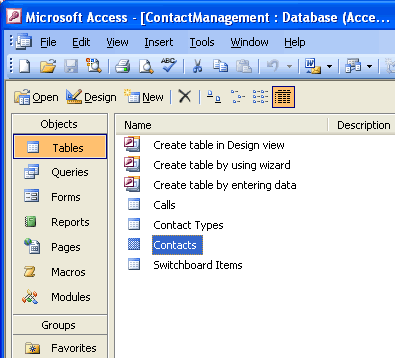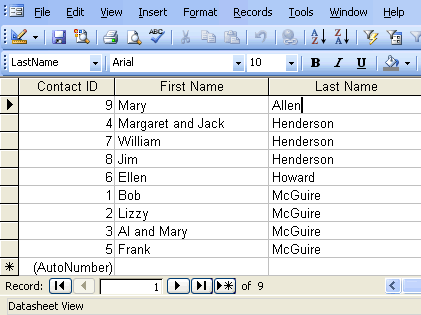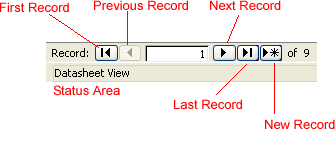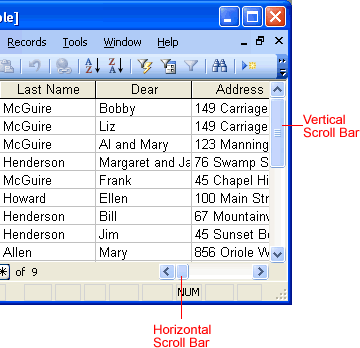Access 2003 -
Opening a Table and Learning to Navigate Records

Access 2003
Opening a Table and Learning to Navigate Records



/en/access2003/using-a-wizard-to-create-the-contact-management-database/content/
Tables are created and maintained in the Tables tab of the Objects palette in Microsoft Access. The Contact Management database contains four tables: Calls, Contact Types, Contacts, and Switchboard Items. We will discuss the Contacts table in this lesson.
A table opened in Datasheet view resembles a Microsoft Excel spreadsheet. It is used to input records into the database and will be discussed in this lesson.
 Contact Management: Database from the menu bar.
Contact Management: Database from the menu bar.
The Datasheet view looks like an Excel spreadsheet. It consists of columns and rows. Field names—Contact ID, First Name, Last Name, Dear, Address, City, State, etc.—appear as column headings. Records represent rows with data input into the fields. The number of rows that appear in the table will equal the number of records that have been added to the table. One blank row always appears as the last row of the database. This blank row is used to add a new record the table.

The status area in the bottom-left area of the window indicates the number of records in the table, as well as the record number displayed in the window.

The vertical scroll bar is located along the right edge of the screen and can be used to move up or down the table if the total number of records exceeds the records shown on the screen. Similarly, the horizontal scroll bar located at the bottom of the screen can be used to move left or right across the window if the fields in a table exceed the number of fields displayed on the screen.

Another way to navigate records in a table is to scroll up and down one screen at a time using the PageUp and PageDown keys on the keyboard. Other keys provide shortcuts to move through fields and records, including:
| Key: | Selects the: |
| Tab | Next field to the right |
| Shift + Tab | Next field to the left |
| End | Last field of the record |
| Home | First field of the record |
| Down Arrow | Same field in the next record |
| Up Arrow | Same field in the previous record |
| Page Down | Next screen of table records |
| Page Up | Previous screen of table records |
| Ctrl + End | Last field of the last record in the table |
| Ctrl + Home | First field in the first record in the table |
The Record Selector, located to the left of each record in Datasheet view, identifies the operation being performed against a selected record at any given time.

The Record Selector can display any of the following symbols:
 Indicates the current record; the record is saved with the information displayed on the screen
Indicates the current record; the record is saved with the information displayed on the screen Indicates the selected record is being edited and the changes have not yet been saved
Indicates the selected record is being edited and the changes have not yet been saved Indicates a blank record into which information for a new record can be added to the table
Indicates a blank record into which information for a new record can be added to the table A blank record row always appears as the last row in a table. You must add new table records using this row.
A blank record row always appears as the last row in a table. You must add new table records using this row.
/en/access2003/viewing-and-adding-table-records/content/

